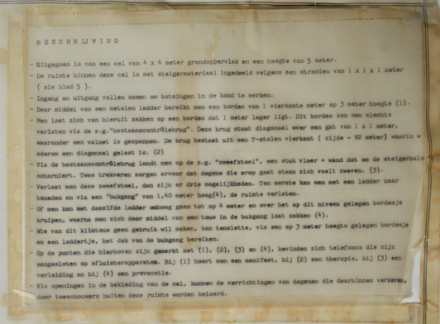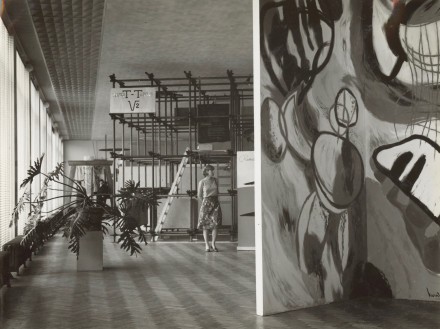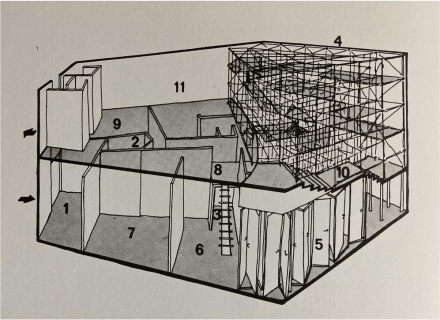Image

Constant worked on his New Babylon project from 1965 to 1974. He sees technological developments and automation as the possibility of saving people from mind-numbing work with which the daily bread has to be earned.
In 1956, Constant says the following about technological developments in architecture: … today architecture can have a construction technique of an endless richness, which makes it an art that is completely independent of pictorial and sculptural decoration, without however reverting to sterility of functionalism. She will be able to use technology as an artistic medium, equivalent to sound, color and word in the other arts. She will integrate in her aesthetics the handling of volumes and voids of the sculptor and the spatial colourism of the painter to create a complete art, which is at the same time lyrical in its means and social in nature. It is in poetry that life will be home.
In 1958 he writes:
… The machine is an indispensable model for all of us, even artists, and industry is the only means of meeting the needs, even aesthetic ones, of humanity on a global scale today. These are no longer ‘problems’ for artists, this is a reality they cannot ignore. those who despise the machine and those who glorify it show the same inability to use it. machine work and mass production offer unprecedented possibilities for creation, and those who know how to put these possibilities at the service of a bold imagination will be the creators of tomorrow. The artist’s job is to invent new techniques and make use of light, sound, movement and whatever invention that could influence the atmosphere.
[1] ‘Demain la poésie logera la vie’, geschreven in Parijs, 19 augustus 1956, als lezing tijdens het Eerste Wereldcongres van Vrije Kunstenaars georganiseerd door de M.I.B.I. (Mouvement International pour un Bauhaus Imaginiste contre un Bauhaus Imaginaire), gehouden in Alba (I), 2–8 september 1956.
[1] On our means and perspectives, Internationale Situattionisten #2, 1958

Constant believes in the technique in the hands of the artist. In addition, he also developed various projects with architects and artists from different disciplines, where the starting point was always to make his ideas playable, to be experienced more than regarded. In exhibitions he presented his models in such a way that the audience should feel that they were surrounded by them or that they were in them.
It’s plausible that Constant himself would have liked to have researched the possibilities of techniques such as VR. This idea was the starting point for thinking about what Virtual Reality could mean for New Babylon, which was the beginning of the Enter New Babylon project.
In the spirit of Constant it also had to be a project in which the artist (designers and writers) would actually use this technique as a tool in their art and not that they would use it as architects once use color in their work, only as decoration. In our view, Enter New Babylon is almost inevitable.
Below a number of examples of Constant’s “immersive” projects based on archive material and photographs of reproductions.
In 1959 Constant exhibits his “space” models at the exhibition Constant, constructies en maquettes Stedelijk Museum Amsterdam. He positions them dynamically on a black background, as if suggesting endless space. In 2016 this set up is reconstructed by Ludo Van Halem for the exhibition Constant. Ruimte + kleur at the Cobra Museum for Modern Art.
In 1965 Constant works with Nic Tummers for the exhibition Nieuw Beelden at Stedelijk Museum Amsterdam. They create the Installation T-T √2 Omgang in which the audience can climb and wander around. Nic and Constant give specific directions on what can be experienced in the installation.


In 1965 Constant also creates a lifesize labyrinth for the exhibition Taal en Teken Gemeentemuseum Den Haag (Kunstmuseum).

In 1966 Constant is part of team c.t.p.w (Constant, Tummers, P…, Weehuizen). The team creates E.S.R (Experiment Studio Rotterdam) a massive installation, a sort of playground for grown ups.

In 1969 Constant creates the Ludic Stairs for the exhibition Wegwezen. Recreatie vroeger, nu en straks at Amsterdam Hitsorisch Museum (Amsterdam Museum), which were recreated in 2016 for the exhibition Constant, New Babylon. To Us Liberty at Kunstmuseum Den Haag.
In 1974 Constant finished his New Babylon project with a major exhibition at Gemeentemuseum Den Haag (Kunstmuseum Den Haag). He created a dark room in which he positioned his models at different heights with a spotlight on them. As if he wanted to suggest they were suspended in the air. In 2015–2016 this room was reconstructed for the exhibition Constant. Nueva Babilonia at Museo Reina Sofia in Madrid and at Constant, New Babylon. To Us Liberty at Kunstmuseum Den Haag.

